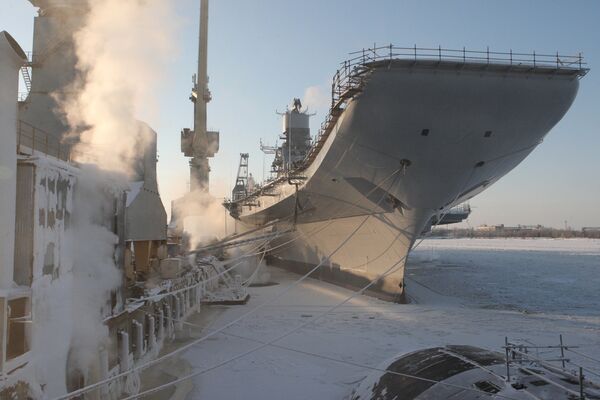Sea trials of an Indian Navy aircraft carrier refitted by a Russian shipyard were unsuccessful due to design failures in the vessel's boilers, Russian daily Vedomosti wrote on Tuesday quoting the shipyard's former director Oleg Shulyakovsky.
The ship's handover to the Indian Navy was put back from December 2012 to at least October 2013 after propulsion failures occured when the Vikramaditya, formerly the Russian Navy's Admiral Gorshkov, underwent sea trials in the White Sea last month.
Shulyakovsky says three of the carrier's eight boilers failed, but the ship still managed to stay underway and reached 23 knots, below its design speed of 29 knots.
Boiler failures were a legacy of the original vessel's design, he said, with propulsion snags being a persistent feature of the four Project 1143 carriers built in the Soviet Union in the 1970's. The carriers boilers lasted just 20 percent of the design life stated by their makers, he said.
The replacement boilers installed as part of the vessel's $2.3 billion refit were guaranteed for just ten months, which expired before the ship took to sea, he said.
Specialists from the Baltisky Shipyard and boiler design bureau are already at Sevmash shipyard, where the carrier will arrive in the next few weeks. Engineers are focusing on the boilers' heat insulation as the core of the problem. Repairs could take from four months to a year depending on the damage to the insulation, he said.
The worst case would be damage to the pipes carrying steam from the boilers, Shulyakovsky said. The pipes are made from a special steel which is no longer made in Russia. The steel used in Vikramaditya's pipes was made in Ukraine.
A defense industry official quoted by Kommersant newspaper on Monday, who prepared the Vikramaditya for sea trials, said the reason for the boilers’ failure was that India refused to use asbestos to protect the boilers from heat, fearing that the material was dangerous for the crew. Instead, it used firebrick, which had poorer insulating properties.
The purchase and refit of the Vikramaditya has experienced a long-running catalog of failures and setbacks.
India and Russia signed the $947 million dollar deal in 2005 for the purchase of the carrier, with an original deadline for the refit's completion of 2008. Delivery was delayed twice, pushing up the cost of refurbishing the carrier to $2.3 billion.
Both sides were locked in protracted arguments over who would pay the extra costs, as it became clear that the refit would be much more complicated than originally envisaged. A new agreement was signed in 2009 with the Indians agreeing to pay for the extra work needed.
Another Sevmash shipyard director, Vladimir Pastukhov, was fired in 2007 over his poor management of the project.
The Vikramaditya was originally built as the Soviet Project 1143.4 class aircraft carrier Baku.
The ship was laid down in 1978 at the Nikolayev South shipyard in Ukraine, launched in 1982, and commissioned with the Soviet Navy in 1987.
It was renamed Admiral Gorshkov after the collapse of the Soviet Union in 1991. In 1994, the Admiral Gorshkov sat in dock for a year for repairs after a boiler room explosion. In 1995, it briefly returned to service but was finally withdrawn and put up for sale in 1996.
The ship has a displacement of 45,000 tons, a maximum speed of 32 knots and an endurance of 13,500 nautical miles (25,000 km) at a cruising speed of 18 knots.
India has already started taking delivery of the MiG-29K naval fighter aircraft for the Vikramaditya, as they were ready before the refit was completed. The MiG-29Ks will operate in STOBAR (short take-off but assisted recovery via arresting wires) mode.



